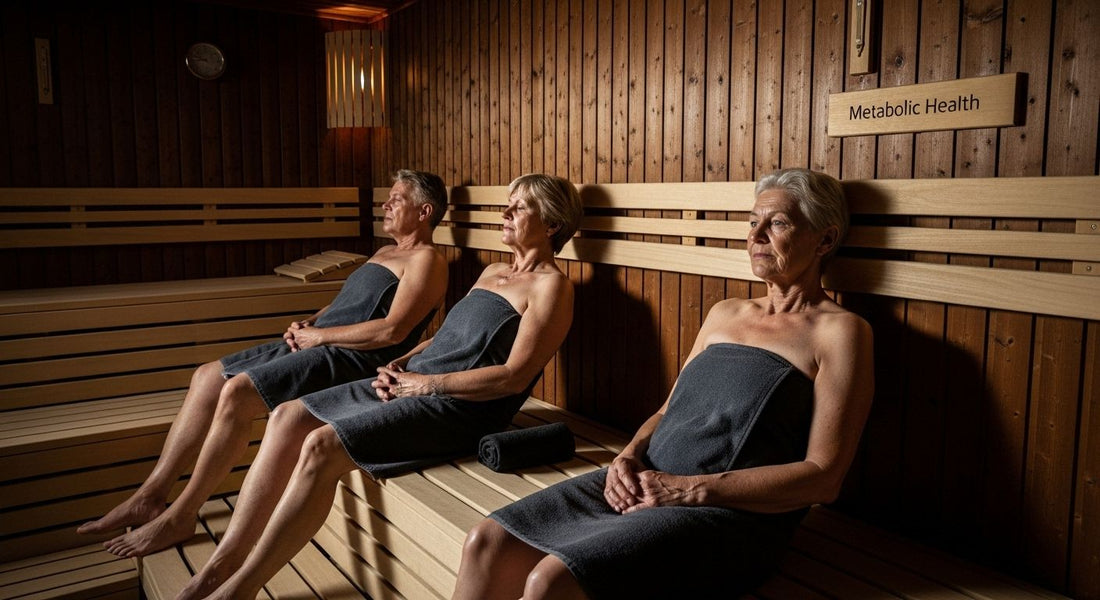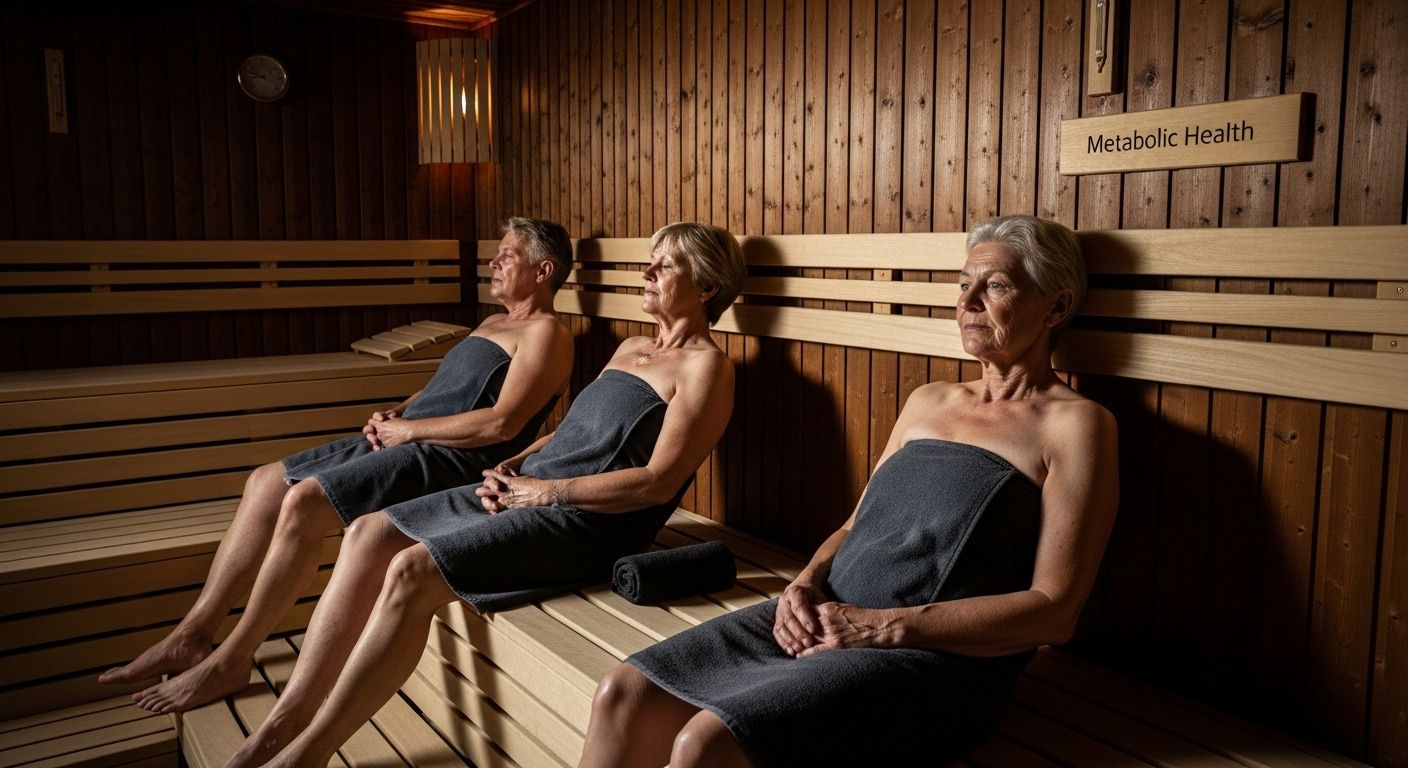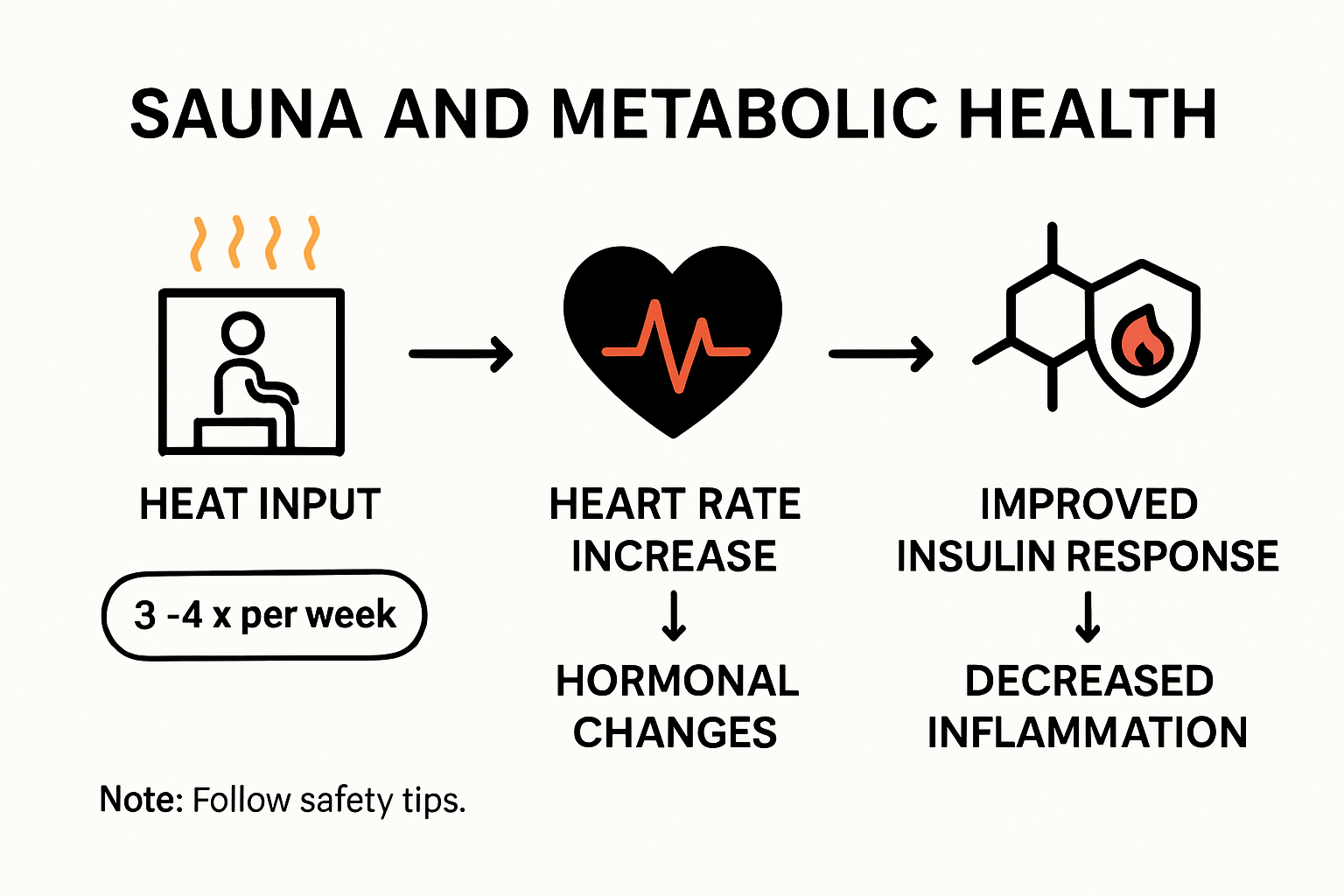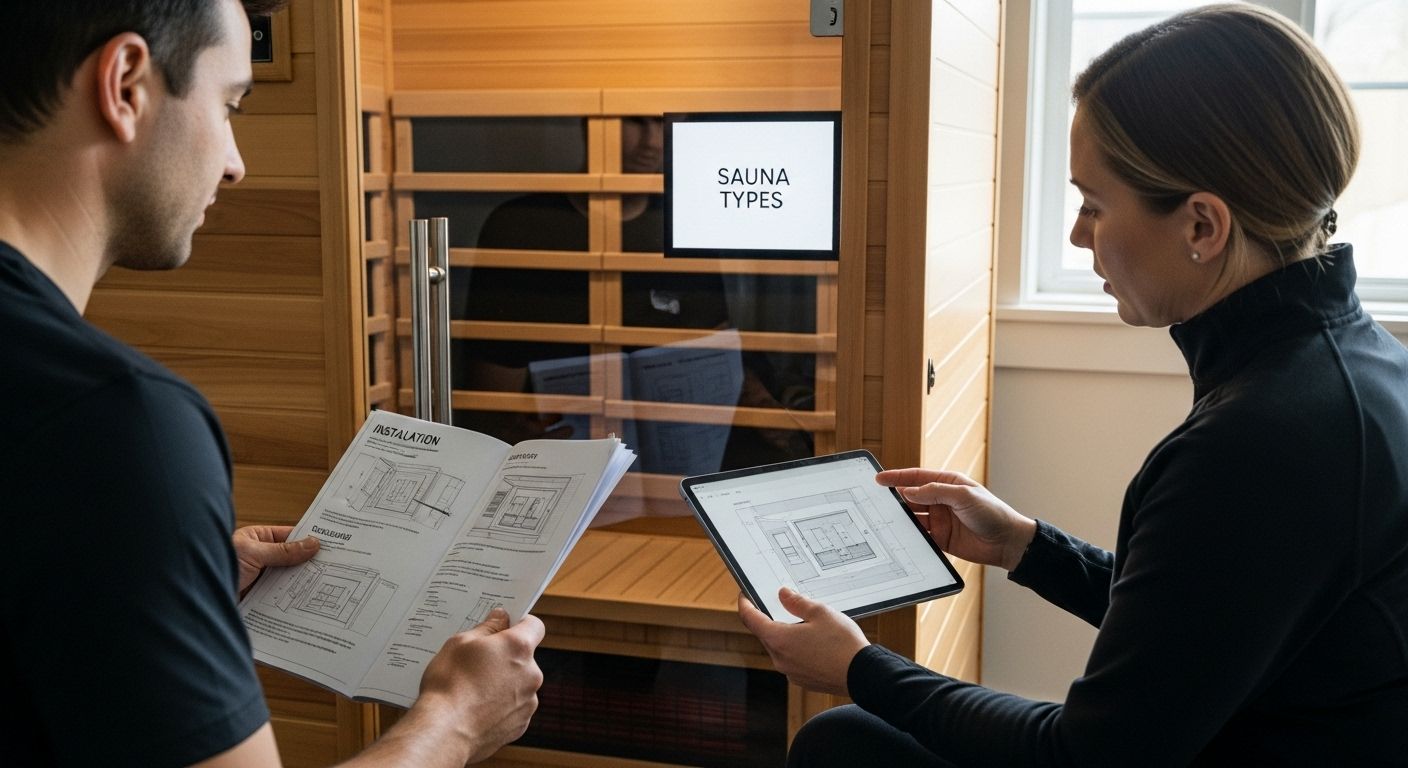
Sauna and Metabolic Health: Benefits, Research, and Tips

Sauna sessions have gained serious attention for their role in metabolic health and not just for relaxation. Studies show that regular sauna use can improve insulin sensitivity and mimic the effects of moderate-intensity exercise. Most people expect a sauna to simply make you sweat and help you unwind. Surprisingly, it could be a powerful wellness tool for supporting everything from blood sugar regulation to long-term cardiovascular health.
Table of Contents
- How Sauna Sessions Support Metabolic Health
- Key Research On Sauna And Metabolism
- Practical Sauna Tips For Better Wellness
- Choosing A Sauna For Your Home And Needs
Quick Summary
| Takeaway | Explanation |
|---|---|
| Sauna sessions enhance metabolic health. | Regular sauna use mimics exercise responses, boosting metabolic activity and promoting overall wellness. |
| Consistent use improves insulin sensitivity. | Heat exposure during sauna sessions aids the body’s regulation of blood glucose, which is crucial for metabolic health. |
| Proper hydration is key before saunas. | Staying hydrated helps manage body temperature and supports optimal physiological responses during sauna use. |
| Start with shorter sessions to build tolerance. | Beginners should gradually increase sauna duration from 5-10 minutes to comfortably acclimate to the heat and maximize benefits. |
| Consult with healthcare professionals if needed. | Individuals with specific health conditions should seek medical advice before incorporating regular sauna use into their routine. |
How Sauna Sessions Support Metabolic Health
Sauna sessions offer a powerful approach to supporting metabolic health through a unique combination of physiological responses that mimic exercise and trigger beneficial metabolic adaptations. Understanding how heat exposure impacts our body’s metabolic processes reveals remarkable potential for improving overall wellness.
Metabolic Activation Through Heat Stress
When you enter a sauna, your body experiences an intense heat stress that initiates a complex cascade of metabolic responses. Research from Mayo Clinic Proceedings demonstrates that regular sauna bathing significantly influences metabolic parameters, particularly cardiovascular and metabolic health markers. The elevated body temperature causes your heart rate to increase, similar to moderate-intensity exercise, which stimulates metabolic activity.
During a sauna session, your body works hard to cool itself, engaging multiple metabolic mechanisms. Blood vessels dilate, increasing circulation and metabolic rate. This process triggers a series of adaptive responses that can improve insulin sensitivity and reduce inflammation - two critical factors in metabolic health.
Metabolic Benefits and Physiological Adaptations
Harvard T.H. Chan School of Public Health highlights several key metabolic benefits associated with consistent sauna use:
- Improved Insulin Sensitivity: Heat exposure can enhance the body’s ability to regulate blood glucose more effectively
- Enhanced Cardiovascular Function: Regular sessions support blood vessel health and circulation
- Reduced Inflammation: Sauna sessions may help lower systemic inflammatory markers
The physiological stress of heat exposure prompts your body to become more efficient at managing metabolic processes. A study published in PubMed revealed that the autonomic nervous system responds to sauna bathing by improving cardiovascular adaptability and metabolic function.
Long-Term Metabolic Health Implications
Consistent sauna use appears to offer cumulative metabolic benefits. The repeated heat stress acts as a form of mild hormetic stress, encouraging your body to become more resilient and metabolically flexible. This means your metabolism can more efficiently convert nutrients into energy, regulate blood sugar, and maintain optimal cellular function.
While sauna sessions are not a replacement for regular exercise and a balanced diet, they represent a complementary strategy for supporting metabolic health. The combination of increased heart rate, sweating, and heat-induced physiological adaptations creates a unique environment for metabolic optimization.
Individuals interested in metabolic health should consider incorporating regular sauna sessions into their wellness routine, always consulting with healthcare professionals to ensure safety and appropriateness for their specific health conditions.
Key Research on Sauna and Metabolism
Scientific research exploring the relationship between sauna use and metabolism has unveiled compelling insights into how heat exposure can positively influence our body’s metabolic processes. Emerging studies provide robust evidence supporting the potential metabolic benefits of regular sauna sessions.
Cardiovascular and Metabolic Function Studies
Research published in the International Journal of Environmental Research and Public Health offers comprehensive insights into the metabolic mechanisms triggered by sauna bathing. The study revealed significant improvements in cardiovascular function through multiple physiological pathways. Researchers observed enhanced endothelial function, reduced arterial stiffness, and improved lipid profiles among regular sauna users.
The investigation demonstrated that repeated heat exposure creates adaptive responses within the metabolic system. These responses include improved circulation, increased heart rate variability, and more efficient thermal regulation. Such physiological adaptations suggest that sauna sessions can act as a form of metabolic conditioning, similar to moderate exercise.

Metabolic Health and Weight Management Research
A groundbreaking study presented at the American Society for Nutrition highlighted fascinating connections between heat therapy and metabolic parameters. The research focused on female subjects and discovered that consistent whole-body heat treatments could potentially mitigate weight gain and improve insulin sensitivity.
Key findings from this research indicate that:
- Heat Exposure Impact: Regular sauna sessions may help regulate metabolic processes
- Insulin Sensitivity: Potential improvements in glucose metabolism were observed
- Weight Management: Preliminary evidence suggests potential benefits for managing body composition
Metabolic Syndrome and Long-Term Health Implications
Stanford University’s Lifestyle Medicine department has been investigating the broader implications of sauna use on metabolic health. Their emerging research suggests that consistent sauna bathing might play a crucial role in reducing the risk of metabolic syndrome.
The research emphasizes that while sauna sessions are not a standalone solution, they represent a promising complementary approach to supporting metabolic wellness. The heat-induced physiological stress appears to trigger adaptive mechanisms that could contribute to long-term metabolic resilience.
Researchers recommend further investigation to fully understand the complex interactions between heat exposure and metabolic function. Current evidence suggests that incorporating regular sauna sessions into a holistic wellness strategy could offer meaningful metabolic health benefits.
Individuals interested in leveraging these potential metabolic advantages should consult healthcare professionals and consider their personal health status when integrating sauna sessions into their wellness routine.
Practical Sauna Tips for Better Wellness
Optimizing your sauna experience requires understanding key strategies for safety, effectiveness, and maximum wellness benefits. Proper preparation and mindful approach can transform sauna sessions from simple heat exposure to a powerful wellness tool.
Preparing for Your Sauna Session
Southern Illinois University Medicine recommends a structured approach to sauna use. Beginners should start with shorter 5 to 10-minute sessions, gradually building tolerance to 15 to 20-minute experiences. The ideal sauna temperature ranges between 80 and 212 degrees Fahrenheit, with most experts suggesting a comfortable range of 150 to 190 degrees.
Hydration is critical before, during, and after sauna sessions. Drink at least one full glass of water prior to entering and keep additional water nearby. Wearing light, loose-fitting clothing or using a clean towel helps manage body temperature and ensures comfort during your session.
To provide a quick reference for safe and effective sauna preparation, the following table summarizes essential steps and tips for beginners as outlined in the article.
| Step | Details & Recommendations |
|---|---|
| Begin with short sessions | Start with 5–10 minutes, then increase gradually |
| Optimal temperature range | Most sessions: 150–190°F (not exceeding 212°F) |
| Hydrate before and after | Drink a full glass of water before and keep more handy |
| Clothing/covering | Wear light, loose-fitting clothes or use a clean towel |
| Increase session length cautiously | Work up to 15–20 minutes once comfortable |
| Cool down after sauna | Shower, rest, and rehydrate before activity |
Safety Considerations and Health Precautions
Healthline emphasizes the importance of medical consultation before regular sauna use. Individuals with specific health conditions should exercise caution. These conditions include:
- Cardiovascular Issues: Uncontrolled high blood pressure
- Metabolic Conditions: Unstable diabetes
- Heart-Related Concerns: Heart failure or abnormal heart rhythm
Potential risks can be mitigated by:
- Consulting healthcare professionals before starting regular sauna sessions
- Avoiding alcohol and large meals before sauna use
- Listening to your body and exiting if you feel dizzy or uncomfortable
Maximizing Wellness Benefits
Stanford Lifestyle Medicine highlights that sauna sessions can produce physiological responses similar to moderate-intensity aerobic exercise. To maximize these benefits, consider the following strategies:
Establish a consistent routine of 3 to 4 sauna sessions per week, with each session lasting 15 to 20 minutes. Pay attention to your body’s signals and gradually increase duration and frequency. Combine sauna use with proper hydration, balanced nutrition, and regular exercise for comprehensive wellness support.
After your sauna session, allow your body to cool down naturally. Take a lukewarm shower, drink water, and rest for a few minutes. This helps your body readjust and supports the metabolic and cardiovascular benefits of heat exposure.
Remember that individual responses to sauna use vary. What works for one person might not be ideal for another. Always prioritize personal comfort, listen to your body, and make adjustments as needed to create a safe and enjoyable sauna experience that supports your overall wellness goals.
Choosing a Sauna for Your Home and Needs
Selecting the right sauna for your home involves understanding different types, considering personal health goals, and evaluating space and budget constraints. A thoughtful approach ensures you invest in a sauna that meets your wellness needs and fits seamlessly into your lifestyle.
Sauna Types and Their Unique Benefits
Mayo Clinic highlights the diverse options available, with infrared and traditional saunas offering distinct physiological experiences. Infrared saunas use light to directly heat the body, providing a gentler alternative for individuals who find traditional high-temperature environments challenging.
Three primary sauna types exist:
- Traditional Dry Saunas: High-temperature rooms using heated air
- Infrared Saunas: Direct light-based body heating
- Steam Saunas: High-humidity environments using water vapor
Each type offers unique benefits. Traditional saunas reach temperatures around 1856F, creating intense heat stress. Infrared saunas operate at lower temperatures while providing similar cardiovascular responses, making them accessible for more people.
To help readers easily compare the different sauna types mentioned—and the unique benefits and characteristics of each—the table below summarizes core features and considerations for Traditional Dry, Infrared, and Steam Saunas.
| Sauna Type | How It Works | Key Benefits | Typical Temp Range |
|---|---|---|---|
| Traditional Dry Sauna | Heats air in wood-lined room | Intense heat stress, deep sweating | 150–190°F (up to 185°F) |
| Infrared Sauna | Uses infrared light to heat body directly | Gentler heat, easy on the body, lower temp | 120–150°F |
| Steam Sauna | Produces steam via water on heated rocks | High humidity, easy breathing, relaxation | 110–120°F |

Health Considerations and Space Planning
Harvard Health recommends carefully evaluating health status before sauna selection. Individuals with cardiovascular conditions should consult healthcare professionals to determine the most appropriate sauna type.
Consider these key factors when choosing a home sauna:
- Room Size: Ensure adequate space for comfortable movement
- Electrical Requirements: Verify home electrical system compatibility
- Installation Location: Select areas with proper ventilation
- Personal Health Goals: Match sauna type to specific wellness objectives
Home saunas range from compact portable units to built-in room installations. Measure your available space and consider future mobility needs when making your selection.
Performance and Long-Term Value
National Center for Biotechnology Information suggests that regular sauna use offers potential long-term health benefits. When investing in a home sauna, prioritize quality, durability, and performance over initial cost.
Key evaluation criteria include:
- Construction materials
- Heating element quality
- Energy efficiency
- Warranty coverage
- Maintenance requirements
Infrared saunas typically offer lower operational costs and easier maintenance compared to traditional steam models. Consider your budget not just for initial purchase but for long-term operational expenses.
Remember that a sauna is a personal wellness investment. Take time to research, read user reviews, and potentially test different models before making a final decision. Your ideal sauna should align with your health goals, spatial constraints, and personal comfort preferences.
Frequently Asked Questions
What are the metabolic health benefits of regular sauna use?
Regular sauna use can improve insulin sensitivity, enhance cardiovascular function, and reduce inflammation, which are critical for overall metabolic health.
How does sauna use mimic the effects of exercise?
Sauna sessions elevate body temperature and heart rate, triggering metabolic activity akin to moderate-intensity exercise, which can enhance cardiovascular health and metabolic function.
What should I consider before starting sauna sessions for metabolic health?
Before starting sauna sessions, consider your health status, particularly if you have cardiovascular or metabolic conditions. Consult a healthcare professional to ensure safety and effectiveness.
How can I maximize the wellness benefits from sauna use?
To maximize wellness benefits, establish a consistent routine of 3 to 4 sauna sessions per week lasting 15 to 20 minutes, stay hydrated, and allow your body to cool down appropriately after each session.
Bring Metabolic Wellness Home with Best Life Sauna
You have read the science and you see the amazing benefits of regular sauna sessions for metabolic health. If you are striving for better insulin sensitivity a stronger metabolism and easier stress relief but do not know how to bring these research-backed effects into your daily life then Best Life Sauna is here to guide you. Many of the pain points mentioned in the article—like finding safe consistent ways to support your metabolism at home and choosing between traditional or infrared saunas—are easily solved with the right tools and expert guidance.

Ready to feel the difference for yourself? Visit Best Life Sauna to explore a range of premium traditional and infrared saunas along with wellness accessories that fit your goals. Discover real customer reviews unbeatable offers like free shipping on qualifying orders and educational articles shaped by the latest health research. Take control of your metabolic wellness journey today—see which sauna is right for you at Best Life Sauna and start transforming your routine into a source of daily health benefits.

